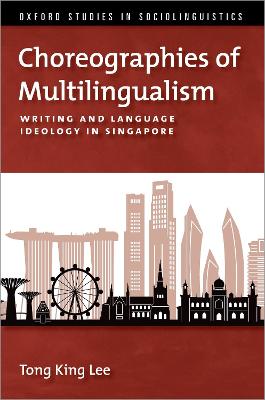Oxford Studies Sociolinguistics
1 total work
Singapore boasts a complex mix of languages and is therefore a rich site for the study of multilingualism and multilingual society. In particular, writing is a key medium in the production of the nation's multilingual order - one that is often used to organize language relations for public consumption.
In Choreographies of Multilingualism, Tong King Lee examines the linguistic landscape of written language in Singapore - from street signage and advertisements, to institutional anthologies and text-based memorabilia, to language primers and social media-based poetry - to reveal the underpinning language ideologies and how those ideologies figure in political tensions. The book analyzes the competing official and grassroots narratives around multilingualism and takes a nuanced approach
to discuss the marginalization, celebration, or appropriation of Singlish. Bringing together theoretical perspectives from sociolinguistics, multimodal semiotics, translation, and cultural studies, Lee demonstrates that multilingualism in Singapore is an emergent and evolving construct through which
identities and ideologies are negotiated and articulated.
Broad-ranging and cross-disciplinary, this book offers a significant contribution to our understanding of language in Singapore, and more broadly to our understanding of multilingualism and the sociolinguistics of writing.
In Choreographies of Multilingualism, Tong King Lee examines the linguistic landscape of written language in Singapore - from street signage and advertisements, to institutional anthologies and text-based memorabilia, to language primers and social media-based poetry - to reveal the underpinning language ideologies and how those ideologies figure in political tensions. The book analyzes the competing official and grassroots narratives around multilingualism and takes a nuanced approach
to discuss the marginalization, celebration, or appropriation of Singlish. Bringing together theoretical perspectives from sociolinguistics, multimodal semiotics, translation, and cultural studies, Lee demonstrates that multilingualism in Singapore is an emergent and evolving construct through which
identities and ideologies are negotiated and articulated.
Broad-ranging and cross-disciplinary, this book offers a significant contribution to our understanding of language in Singapore, and more broadly to our understanding of multilingualism and the sociolinguistics of writing.
